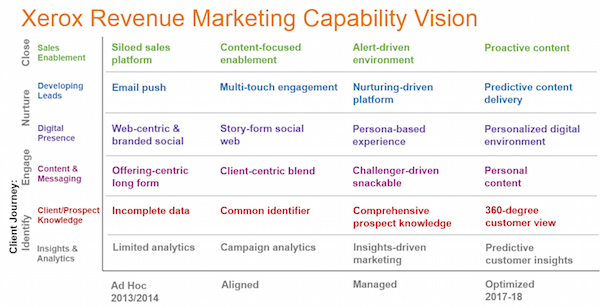There are generally two audiences for my blog: (1) CMOs and marketing executives, who want to understand how technology fits into the bigger marketing picture; and (2) marketing technologists, who know the technology and appreciate a site dedicated to their art. Every now and again, however, I connect with someone who is both a CMO and a marketing technologist.
Such is the case with David Newberry, the Group Marketing Officer of Pitney Bowes Software. My immediate reaction upon running into David on Twitter, where he was kind enough to tweet a couple of my articles, was: “Would you be willing to do a Q&A for my readers?”
David, who writes his own blog on Marketing Art & Science, graciously agreed. So I’m delighted to share his perspective on the intersection of marketing leadership and marketing technology with you.
Start by telling us a little about your background and your role at Pitney Bowes Software. A CMO who is also a marketing technologist is rare. How did you get there?
I started my career at British American Tobacco (BAT) and worked in brand management, trade marketing, and general management, where I had P&L responsibility. In my final role, I was responsible for establishing the company’s global retail strategy and then ensuring consistent execution.
It was at this point that I realized technology could play a major part in the success of both the role and the company. The challenge was how could we influence the behavior of 200 diverse markets and leverage activities across such a global footprint? The answer was simple, I needed to be able to create transparency, enable knowledge exchange and promote collaboration to create leverage and consistency.
Interestingly enough, this was why Tim Berners-Lee invented the worldwide web. It is also why we use the term IT — information technology. It was at that point that I left BAT and co-founded a technology start-up that could address this opportunity and that’s how I ended up being a marketing technologist as you say.
In regard to my current role at Pitney Bowes Software, clearly this experience has helped me greatly, as today we utilize marketing technology both internally as well as offering it to our clients. Just to top it off, we also use our own marketing technology in-house so we get to see both sides of the coin, which is sometimes an eye-opener.
How has your fluency with technology effected your leadership approach as CMO?
I am disciplined about ensuring that objectives, strategy and process must precede any assessment of technology. Technology is a fantastic enabler, but it can’t replace the front-end thinking. If you start with technology, you are doomed.
Technology is a fantastic enabler, but it can’t replace the front-end thinking. If you start with technology, you are doomed.
In today’s world though, this is an easy thing to get wrong as there are now so many great new marketing technologies appearing on almost a weekly basis. It is easy to get sucked in by the next new shiny tool. So if you ever get into the debate of “this is great but how should we use it,” then you should know you are on the wrong track.
I was lucky as my entry into technology was all about how to solve a significant business issue and that thinking has remained with me today.
How is marketing technology managed at your organization today? What’s the relationship between marketing and IT, and how has that evolved over your tenure?
We have a small but very skilled marketing operations team headed up by Allison Smith Terrey who is responsible for both marketing insights as well as technology enablement. Allison has an engineering background, which I believe is a great benefit. This ensures that she is very structured and disciplined about the deployment of technology. We always make sure that we have a strategy and process in place before we test anything.
Allison has an engineering background, which I believe is a great benefit. This ensures that she is very structured and disciplined about the deployment of technology.
In regard to our relationship with IT, this is continuing to evolve. We are now both agreed that marketing can pilot new technologies as long as there is a clear business case connected to a desired outcome. In these cases, we will manage the project, but at the point that the technology has delivered against the objectives, we then work with IT to embed it into the broader organization.
On both sides, we want to make sure that each function sticks to what they do best, so we rely heavily on IT to provide the technical support once the program becomes part of the furniture.
What changing roles and skill sets have you seen in marketing, both within Pitney Bowes and other organizations you work with?
The overriding change is that we understand the need to have in-depth skills in certain areas, and therefore as a function, we are definitely moving from a generalist organization to a specialist skills organization.
As a function, we are definitely moving from a generalist organization to a specialist skills organization.
As an example we have separated the traditional lead generation role into a strategy/content role and a campaign execution role. This allows the individuals to create a more in-depth knowledge around each discipline. This doesn’t pigeonhole people, as we also rotate people across these two areas. But it is a reflection that the increased complexity of marketing requires more in-depth knowledge and skills, and this was our way to help address that.
In addition, there are certain areas where we need dedicated specialists and this would include senior marketing analysts as well as creative experts who can oversee our content strategy and creation.
You write a blog on marketing art and science. Sometimes these are presented as opposing forces, an either/or approach. Can these be synthesized together in a grand unified theory of marketing?
The truth of the matter, in my mind, is very simple: you need both to be able to implement successful marketing programs.
I see customer satisfaction as the outcome of applying marketing science. This requires the organization to understand the customer, to recognize their needs and wants and to provide them with the right offer or response depending on how the interaction is taking place.
On the other hand, customer loyalty is dependent on marketing art. This requires the organization to create an experience that forms an emotional connection with the consumer. A connection that is based on empathy where the consumer can see their values, thoughts and aspirations reflected by the company or brand. This is the “wow” factor.
You most definitely need both, and I believe the best CMOs are the ones who have spent time either in agencies and/or technology companies in addition to being heads of marketing.
What advice would you give to marketing technologists out there who aspire to be CMO one day?
Again, there is a simple answer and this is important, as I think half the battle nowadays is to take out the complexity and create clarity. In my mind, it is to focus on outcomes.
If you understand the business and can help the organization make better-informed decisions, then you are a long way down the road of being able to be a CMO.
The other area that you need to gain competency in is empowering people so they can deliver to their highest level. You need to be able to identify great people, understand their skill sets and empower them to achieve their potential. As a marketing technologist, if done correctly, it is all about enabling people to perform more effectively — so again, this can really help form the foundation for a successful marketing leader.
As a marketing technologist, if done correctly, it is all about enabling people to perform more effectively.
I have to say it has been a great privilege to take part in this discussion and as a marketing technologist you have an uncanny knack to be able to identify the important trends and priorities for today’s marketing leaders. I always look forward to your new insights so thank you again for the Q&A.
Thank you, David!



